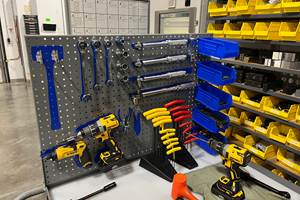The Secret Robot
A manufacturer struggles over its employees’ potential reaction to automation. The struggle itself says something important.
Share



ECi Software Solutions, Inc.
Featured Content
View More.png;maxWidth=45)
DMG MORI - Cincinnati
Featured Content
View More




Rethink Robotics will have its “Baxter” robot at IMTS. Attendees can see the robot in the Advanced Manufacturing Center, booth W-10. As described in this article in MMS’s Industrial Automation supplement, this “collaborative” robot does not run behind guarding, but instead has hardware and systems designed to protect anyone who gets in its way. Thus, the robot works safely beside people. To emphasize its friendliness, it even has a human-like form, with two opposing arms and cartoon eyes on a face-like monitor. And to one user, this very resemblance to a human is part of what makes the robot concerning.
In that Industrial Automation article, I wanted to profile a metalworking user of the robot. However, shops were still too early in their use of it. One of these shops stood out. Its managers asked for their plant not to be profiled because they are keeping the robot a secret from employees. They will continue to keep it a secret, they say, until they can determine how much potential this robot holds for the plant. Their fear is that a human-like robot will be alarming to some employees, appearing too much like a direct replacement for people. Therefore, this plant, which employs hundreds, has its Baxter running in an out-of-the-way room.
That anticipated employee alarm, if real, would be misplaced. One of the plant’s managers told me it takes the facility 2 to 3 years to grow an entry-level employee into a skilled operator. The facility cannot obtain the talent it needs except through this investment. The hope for automation is that it might increase the return on that investment by relieving employees of mundane tasks.
I can’t speak to the employees directly about this issue without betraying the secret. If I could, the view I would offer is that automation safeguards jobs by safeguarding plants. (Here is a great video about this from FANUC America.) With smart use of automation, a facility can run repetitive tasks more efficiently and save cost by reducing error. It can also keep producing through otherwise unused hours (at night, for example), creating capacity that accommodates fluctuating business demand without the plant having to fluctuate staff.
It is rare, in fact, for machining-related automation to lead to job cuts. In machining facilities, things just don’t play out that way. The need for human attention is too great, and skilled workers are too scarce. Implementing robots might affect how many are hired in the future, but for the employees today, the more likely outcome is relief from some of the tedious aspects of their jobs.
In its way, this plant with the secret robot actually illustrates these points. That plant’s management (which gave its blessing to my telling this story as long as it remained anonymous) would not go to all of the trouble to keep this robot under wraps except for one important fact, the fact that makes all the difference. That is: Employees are valuable. How they feel is valuable. Employees are so valuable that even the fear that they might be alarmed is cause for serious concern.
Related Content
How to Accelerate Robotic Deburring & Automated Material Removal
Pairing automation with air-driven motors that push cutting tool speeds up to 65,000 RPM with no duty cycle can dramatically improve throughput and improve finishing.
Read MoreTranslating a Prototyping Mindset to Production
The experimental mindset that benefited BDE Manufacturing Technologies as a prototype job shop has given it an adaptable edge as a production facility.
Read MoreCNC Machine Shop Honored for Automation, Machine Monitoring
From cobots to machine monitoring, this Top Shop honoree shows that machining technology is about more than the machine tool.
Read More3 Ways Artificial Intelligence Will Revolutionize Machine Shops
AI will become a tool to increase productivity in the same way that robotics has.
Read MoreRead Next
Registration Now Open for the Precision Machining Technology Show (PMTS) 2025
The precision machining industry’s premier event returns to Cleveland, OH, April 1-3.
Read More5 Rules of Thumb for Buying CNC Machine Tools
Use these tips to carefully plan your machine tool purchases and to avoid regretting your decision later.
Read MoreBuilding Out a Foundation for Student Machinists
Autodesk and Haas have teamed up to produce an introductory course for students that covers the basics of CAD, CAM and CNC while providing them with a portfolio part.
Read More




































.jpg;maxWidth=300;quality=90)











